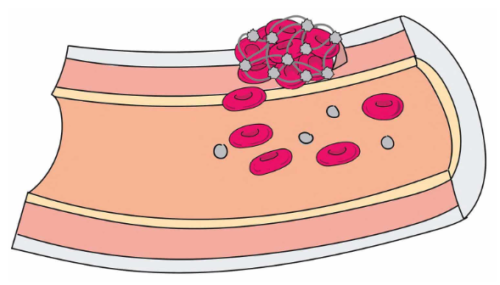2024-04-11 ノースカロライナ州立大学(NCState)

This illustration shows platelets (white blobs) and blood cells forming a fibrin matrix clot at the site of a puncture in a blood vessel. The illustration is by Daniel Donnelly, and was shared by ASCCC OERI under a Creative Commons license.
<関連情報>
- https://news.ncsu.edu/2024/04/synthetic-platelets/
- https://www.science.org/doi/10.1126/scitranslmed.adi4490
超軟質血小板様粒子がげっ歯類およびブタの外傷モデルで出血を止める Ultrasoft platelet-like particles stop bleeding in rodent and porcine models of trauma
KIMBERLY NELLENBACH, EMILY MIHALKO, SEEMA NANDI, DREW W. KOCH, […], AND ASHLEY C. BROWN
Science Translational Medicine Published:10 Apr 2024
DOI:https://doi.org/10.1126/scitranslmed.adi4490
Editor’s summary
Platelet transfusions are frequently required to control bleeding in patients with acute trauma; however, storage requirements limit their use in the prehospital setting. Synthetic platelet-like particles (PLPs) may be an alternative for immediate treatment of uncontrolled bleeding. Here, Nellenbach and colleagues constructed and optimized synthetic PLPs using ultrasoft and highly deformable nanogels coupled to fibrin-specific antibody fragments. In rodent models of liver laceration, these PLPs reduced blood loss without off-target clot formation, even in the setting of dilutional coagulopathy, leading to improved healing 1 week after injury. These findings were confirmed in pigs with liver laceration, where the PLPs were renally cleared, despite their size. These findings support the further study of synthetic PLPs for the treatment of uncontrolled bleeding in trauma. —Melissa L. Norton
Abstract
Uncontrolled bleeding after trauma represents a substantial clinical problem. The current standard of care to treat bleeding after trauma is transfusion of blood products including platelets; however, donated platelets have a short shelf life, are in limited supply, and carry immunogenicity and contamination risks. Consequently, there is a critical need to develop hemostatic platelet alternatives. To this end, we developed synthetic platelet-like particles (PLPs), formulated by functionalizing highly deformable microgel particles composed of ultralow cross-linked poly (N-isopropylacrylamide) with fibrin-binding ligands. The fibrin-binding ligand was designed to target to wound sites, and the cross-linking of fibrin polymers was designed to enhance clot formation. The ultralow cross-linking of the microgels allows the particles to undergo large shape changes that mimic platelet shape change after activation; when coupled to fibrin-binding ligands, this shape change facilitates clot retraction, which in turn can enhance clot stability and contribute to healing. Given these features, we hypothesized that synthetic PLPs could enhance clotting in trauma models and promote healing after clotting. We first assessed PLP activity in vitro and found that PLPs selectively bound fibrin and enhanced clot formation. In murine and porcine models of traumatic injury, PLPs reduced bleeding and facilitated healing of injured tissue in both prophylactic and immediate treatment settings. We determined through biodistribution experiments that PLPs were renally cleared, possibly enabled by ultrasoft particle properties. The performance of synthetic PLPs in the preclinical studies shown here supports future translational investigation of these hemostatic therapeutics in a trauma setting.


